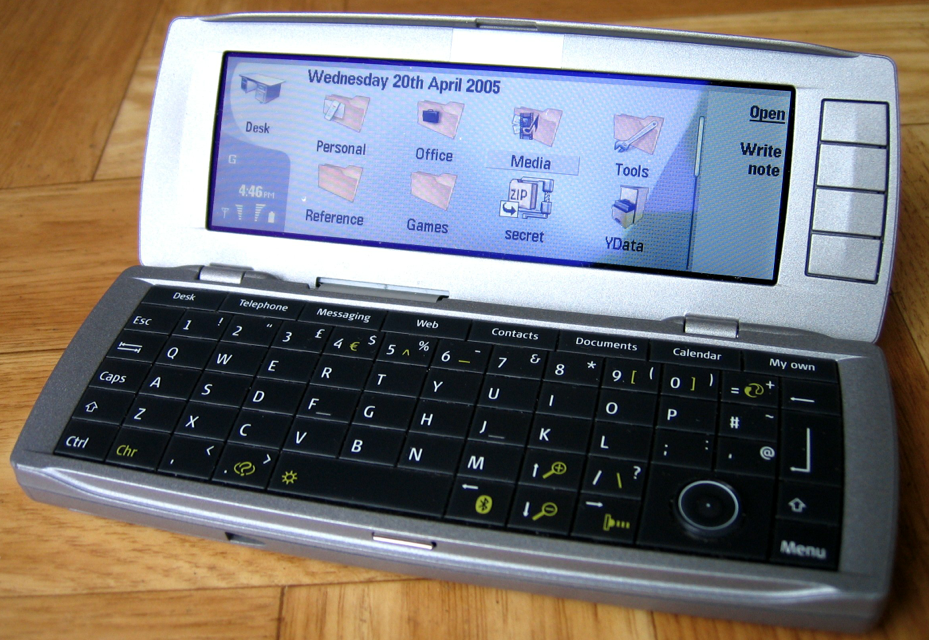Genuine question.
I know they were the scrappy startup doing different cool things. But, what are the most major innovative things that they introduced, improved or just implemented that either revolutionized, improved or spurred change?
I am aware of the possibility of both fanboys and haters just duking it out below. But there’s always that one guy who has a fkn well-formatted paragraph of gold. I await that guy.
The graphical user interface.
They don’t invent it (xerox PARC did), but Apple correctly identified that the user experience of existing computer systems was holding it back from being a thing everyone owns, and made computers a bad fit for many types of work that seem extremely obvious now (digital media creation particularly)
They did this more or less again with the smartphone: business folks and super nerds were the smartphone market before Apple. Now it’s the average person’s computer.
The graphical user interface.
A million times this. Not only did they popularize the ideas, but MacOS’s UI design was so ahead of its time that it’s barely changed since then. It was by far the most polished operating system at the time. Old Apple actually was innovating while the market was kind of stagnant.

This screenshot was in 2007. The competition was Windows Vista. It’s a night and day difference. I had this version of the iMac at the time and was super impressed, even if I did switch back to Windows a couple of years later. Looking back at it, it still looks quite “modern”.
Just to piggy back on this comment, OSX was released before 9/11 and windows XP, so Microsoft was still selling Windows ME at the time! Aside from the desktop backgrounds looked very similar.
I’ve got an '08 iMac with this version of MacOS, El Capitan I believe. Going from that to my 2019 M1 MBP running Sonoma is really no different. Sure there’s features missing but I can still sync my notes and the few other Apple things I actually use between the two.
Plus my iPods can still sync with both devices, they just moved iPod into Finder in the new versions.
It still blows my mind that Apple are so happy to drop OS support on iPhones and iPads that are considered too old, but I can still sync my 4th gen iPod with my M2 Air. There’s damn near 20 years between those two devices, but aside from needing a USB A>C dongle, they work together without any trouble.
Well, I will say it’s a little different. Your iPod doesn’t get software updates or apps. From a functional standpoint it’s about as supported as any old iPhone or iPad is.
Yes, that’s very true.
It does make me laugh when it tells me that my iPods’ various softwares are up to date, and that it’ll check again next time. You can check, but you’ll not find anything…
I feel old.
Time to schedule your colonoscopy gramps
Well, KDE3 could look cool too.
I’ll admit, back then I really wanted a Mac.
Just after trying to use them a few times I know that behavior is more important than appearance on screenshots. Also such looks exhaust you emotionally.
Wrong wrong wrong. Macontoshs gui was crap and buggy as hell. Every seasoned it expert knew it was a shit lousy interface designed to dupe people into believing it was secure when in fact it proliferated viruses and security holes, and drove the control of computing into an avaricious humanity destroying company culture known as apple. DO NOT EVER PROMOTE THE GUI AS GOOD. ITS CRAP.
buggy as hell
No it wasn’t
viruses and security holes
That has nothing to do with GUI
No it wasn’t
OSX 10.0 in general actually was. Jobs offered 10.1 for free as an apology, and it fixed a lot of things.
and i think in general, their attempt to really focus on user experience first always seemed to define their business… trying to make things that people would WANT to use was what made Jobs and Apple stand out… other brands were better known for performance, for example…
Exactly. They innovated
- a GUI that people wanted to use and ushered in a new era of computer guys
- several times a personal computer it laptop that people wanted to use and set new standards for others to follow
- personal music devices that worked so well they set the standard.
- a phone that just works and set many standards for other phones to follow
- an App Store that set standards for usability and security, and set a high bar for others to follow
- a mobile payment system that’s secure and private, and set a standard for the industry to follow
- shared resources and config across devices and family members, setting new standards for usability and convenience
I could probably go on for a while. The thing is that everything in tech is an iteration: almost nothing is completely new. Apple has consistently applied design and usability to revolutionize many different areas of tech. It is true innovation with real change and huge impact
The iPod wasn’t very special. Lots of competitors in that space.
Their phone wasn’t very special. It lacked a lot of features like enterprise email for 1-2 years. It was also slow and locked to a slow carrier in the US for that time.
They managed to sell it though. Their ads and marketing is always been great even if the devices weren’t.
Lots of competitors in that space.
Sure, but none of them in such a small size with such a relatively big capacity, and certainly none that were as easy to use and easy to sync. Apple absolutely rewrote the book on how a portable music player should be, then did it all over again with the iPhone.
Creative had an mp3 player that was small and had large capacity. I think they released ahead of the iPod. There were a lot of mp3 players in this space and Apple didn’t rewrite anything.
Windows media player had all of the same features as iTunes.
The Nokia n95 was a better phone than the iPhone in every comparison in 2007. If Apple did anything, they ignored how slow 2g/2.5g speeds were, and how cumbersome touchscreen keyboards were and marketed it as a better device. I think a few other companies tried this too but got out-marketed by Apple.
Prior to the first iPod, Creative’s only hard drive based portables were the Nomads, both of which were roughly the same size as a portable CD player, and heavier. Don’t get me wrong, they were cool, but they were literally twice the size of an iPod.
In '03, two years after the first iPod came along, Creative released the Zen, which was a similar physical size to the iPod. It was nowhere near as cool to use an an iPod, and was nowhere near as beautifully designed.
There were a lot of mp3 players in this space and Apple didn’t rewrite anything.
There were, and they all used some kind of low capacity removable storage. You can shout and holler all you like, but the fact is that Apple were the first company to make a pocketable, high capacity (for the time) music player. As with so many other of their products, they didn’t invent the market, but they refined it down to something that people would rush out to buy, or wish they could afford.
The Nokia n95 was a better phone than the iPhone in every comparison in 2007
Yeah, I get where you’re coming from. The N95 was a beast of a phone. But don’t forget that Nokia had been banging out phones for 20 years by that point, they’d nailed their market and knew a thing or two. The first iPhone was Apple’s first foray into the market, and while the thing wasn’t perfect (only had GPRS/Edge, no apps, limited features, weird headphone jack) it hit the ground running and was a platform for bigger things. Apple innovated.
And yeah, touchscreen keyboards were cumbersome. On resistive screen phones. I remember using an iPod touch shortly after they came out, and was blown away by how much better the keyboard was on that beautiful capacitive screen, and how shoddy my HTC Kaiser felt by comparison.
Windows Media Player 9 only ripped CDs to WMA files because it didn’t include a licensed mp3 encoder. It didn’t support MP3 ripping directly until WMP10 in 2004.
This is a very ignorant take. MP3 players before the iPod sucked for most people. Obtaining music that was properly tagged or ripping CDs with command-line apps was out of reach for the majority of people.
Saying that the iPhone wasn’t special is also crazy. The best-selling smartphone of all time wasn’t special?
Unbelievable…
At the time of release it it wasn’t. Palm was better. Blackberry had advantages in data speed and email. The iPhone couldn’t take advantage of its browser because of how slow mobile internet was.
The iPod at release was up against a number of players that were nearly identical.
Apple marketed its products better than everyone else, and by 2008 had definitely come up with winning products, but to say its stuff was unique or better at release is revisionist history.
Nonsense. Palm was not better. I sold Palm, Treo, and Blackberry phones at the time and the sudden drop in confidence was palpable. Your second statement is completely wrong too. The entire difference between the iPhone was that it didn’t use mobile web. Safari was a desktop-class browser, unlike the others (minus Flash, obviously). Even Windows devices like PocketPCs didn’t have full browsers.
Again, the iPod statement is just flat-out false. The alternatives at the time were Walkman devices, Creative Labs devices, and devices from Diamond, and crap like the RCA Kazoo. All of them had tiny LCD displays, 256MB of memory max, and transferred music like glorified flash drives. Tags had to be managed manually. Playlists weren’t a thing unless you created them in separate software. There was nothing “identical” about them.
Steve Jobs pulling out a 5GB iPod from his pocket broke the industry and started the whole market, changing the field from a niche for nerds into music for everyone. On top of that, it started the podcast revolution and that is undeniable. To say that it wasn’t unique or better is revisionist history.
You don’t remember how slow the iPhone browsing experience was when it came out? Speeds were capped at 128knps. Or how bad AT&T was in providing bandwidth? Granted other phones besides blackberry had bandwidth issues too, but 2007-2008 was effectively not usable without wifi. It wasn’t until iPhones could work on Verizon’s network that mobile iPhone browsers were usable.
Large capacity mp3 players existed when the iPod came out. Comparing the iPod to the cheap, low-capacity ones is disingenuous.
Granted, the market needed a kick in the ass and Apple did do that, but it’s not like they were the only ones doing it.
Jobs really wanted to make tech usable for the mainstream. Just look at the first iPod all the other MP3 players at the time were for the geeks and music nerds. They were clunky, had ugly geek esthetics and the software was hard to use for most people. And the non techies had no idea where to get mp3s. The iPod together with the iTunes Store really sold the MP3 player to the masses.
Wrong wrong wrong. It was never about ease of use. It was always about taking control away from the user, and hiding authority for control. This kind of deceptive practice has led to what we gave today - cars selling subscription hearing seats. The truth is, the gui was always buggy and a product unfit for its purpose from day one. Apple sold it as a means to get consumers to accept a defective product from the start, perpetuating their ability to always sell updates, forcing consumers to pay for things THEY DO NOT NEED.
They don’t invent it (xerox PARC did), but Apple correctly identified that the user experience of existing computer systems was holding it back
Fucking everyone except Xerox BOD figured that out.
Wrong wrong wrong. The graphical user interface is crap and will always be crap. The whole matter of popularity is marketing bunkum. Console command interface was al ways faster and better than any gui for general computing tasks. The gui is fine for office tasks, but shit for everything else. The popularity of the gui today has driven a massive upscale of cruddy bloated virus infected software. The fact that most people now only know gui has meant that control of viruses has slipped away. Had console commands been the mainstay for computing, viruses and security holes would never have been allowed to proliferate as they do today.
Bud, you sound like a technophile geek. The kind of person who custom built his own computer. You’re not the target customer. Apple builds products for people that don’t care about technology, they just care about what the technology does and want it to be easy and seamless. And that is a vast majority of the people.
I built my own computer but as a working laptop there is nothing close to a decked out MacBook Pro. Yes, I’m aware of the price, but my company paid it, and it was a good choice from every angle.
Bingo. Apple builds appliances.
Let me guess, you use arch?
If this guy isn’t rolling his own distro he’s basically a scrub like the rest of us.
While you may be correct I think you’re still missing the point. CLI is for super nerds. While you and I may know how to use it, the average person doesn’t, and is unlikely to put in the effort to learn. That is the innovation that Apple made in bringing computing to the mainstream. It was precisely because people didn’t have to learn how to navigate the CLI environment and instead got an easy point-and-click interface that computers caught on with the public at large, and that gained Apple an absolute ton of cash money and noteriety.
Awww… I’m a supernerd? Thank yoooooou ❤️ ❤️ ❤️
I always considered myself to be kind of an average run-of-the-mill nerd.
OS X has a decent terminal app and has zsh included as default shell. Mac OS 9 effectively had no CLI at all.
The first virus was made in 1986 for IBM personal computers. Nothing is free from computer viruses. Not macOS, not iOS, not Android, not GNU/Linux, not freeBSD, not even an IBM PC from the 80s. All software can be exploited. The only reason GUI software is the most exploited is because it is what people use. https://en.wikipedia.org/wiki/Brain_(computer_virus)
GUI is not only intended for office tasks. In fact, I would argue that many office tasks are better suited for command line, but I’ll agree that nobody knows how to do that anymore.
GUI was always best suited for artists. Apple has, for a long time, especially since OSX, been explicit about catering to artists. Can you imagine editing video in a terminal? Or editing a layered image? Or producing music?
Can you imagine editing video in a terminal? Or editing a layered image? Or producing music?
I genuinely can’t. How atrocious would that be?
telnet telehack.comThen run
starwarsOn Mac:
nc -c telehack.com
There’s an old saying in computing. “you improve usability by taking away options and features” apple didn’t necessarily invent this mindset. But they perfected it.
They took BSD, a security focused, but not very user friendly, offshoot of Linux/unix and made it “popular” by adding several layers of polish and doing a lot of the configuration work for you and made it osx. This was a time when Linux usability/management on the personal/newbie scale was garbage. If you wanted to install a certain distro of *nix, you better make sure you have supporting hardware and the right up to date tutorial, which is managed by an unknown volunteer, which was usually some person bored on the weekend a few months ago and never updated, they’ve made *nix installation and management a lot better though recently.
They also did this with music. People used to have large collections of unorganized mp3s in the early 00s, unless you were really anal and had a lot of time in your hands, because you were likely downloading them from several different illegal places, and legally buying mp3s were all over the place. You could buy the album off this weird obscure website that you didn’t want to trust with your CC information, because there were a lot of mom and pop music stores online. Then apple brought out iTunes and allowed both buying and managing (and eventually upgrading, traveling around with) music to be dead simple.
For smartphones, they stole a LOT from BlackBerry, but they took it to the next level. Blackberry had email, a private messaging network, and mobile web scrolling waayyyy before anyone. And so many people loved it so much that even Obama famously didn’t want to give his up when he took office. Then apple came out with the iPhone, and blew it away with a bigger screen and again, a lot more polish.
Innovation happens in small steps over years. Apple didn’t invent mobile phones, smart phones, tablets, or computing, they didn’t invent security, encrypted audio/video calls, or music management. They’ve done a lot of crappy stuff, and they charge super high amounts of money for less than state of the art hardware. Their innovation could be summed up by this profound statement I remember a friend said to me once around 2003/4.
“Osx, because making Linux pretty was easier than fixing Windows”
Came here to say something similar about touchscreens on phones. It’s probably the most impactful innovation they’ve had, and ever will have imo. I can’t ethically support Apple as a company and I haven’t owned an apple product since the first iPod touch, but they absolutely deserve credit for this one.
Even if they didn’t invent the touch screen, or even the touchscreen phone, they certainly figured out how to perfectly integrate touchscreens into mobile devices a fluid and intuitive user interface which served as a canvas on which to build pretty much anything you wanted in the form of a mobile app (a $200B+ industry which the iPhone absolutely catalysed the explosive growth of).
It arguably even began a significant change in the course of modern human interaction, due to how much more versatile and therefore more commonly used mobile phones with a similar UI basis became since then; because of that, increasingly popular social media platforms now had a new way to provide use for their platform (via mobile apps) on a device that pretty much everyone now had with them all the time. I don’t think it’s coincidence that social media use saw such substantially explosive growth soon after the iPhone and subsequent “copycats” were on the market.
So their innovation here was really the first step in a number of global paradigm shifts. It was just such a monumentally impactful step forward. Because of this I genuinely think that the iPhone is almost guaranteed to be in history books for centuries, like the printing press or the light bulb.
They’ve also excelled at seamless integration across devices. I can start an iMessage conversation on my iPhone, switch to my laptop for a while, then to my iPad.
Same thing with phone calls. If my phone is on the other side of the house and starts ringing, then both my laptop and iPad ring as well. I can grab whichever device is closest and answer the call on it.
Seamless integration has been around since the first real-time chatrooms though. Again, just making a better UI
For phone calls that’s just VoIP which was around waaaaayyy before the iPhone, Skype was doing something similar in the consumer geek market in 2004/5. They just brought it to the big consumer market, and again, made it 1000x easier to do.
This is something that can easily be done on Windows and Linux also, its just not an out of the box setup like Mac
It’s pretty out of the box now with windows and android. You have to link the two but then it just works (I don’t find it a useful feature though)
Apple purchased their touch screen division from people who had been working on touchscreens for decades before them.
Are you saying that other people had been working on and creating what became Apple’s mobile phone touchscreen interface, and they just bought the already near-finished product? If that’s the case I wasn’t aware.
Or if you’re trying to correct me (I assume you’re not, but you never know), I did acknowledge that Apple didn’t invent the touch screen or touch screen phone, the tech has been around since the 1960’s and even on phones since the early 90’s iirc.
Lots of things like pinch-to-zoom, auto-switching the phone from portrait to landscape mode depending on how it was rotated, basically the actually-usable-as-a-browser features that are part of every modern touchscreen, were originally popularized by Apple. They were the first to make a touchscreen UI that rivaled a desktop computer instead of a pretty substandard WAP interface.
You’re giving way too much to Apple. The important part of the touchscreen was cost. It wasn’t viable as common tech until the cost came down. Apple was just riding that curve down and decided when to make a product.
Sure, cost was almost certainly taken into account, they are a business after all.
But they didn’t just get lucky by gambling touch screens and waiting to become cheap enough. Take a look at the user interface of the touchscreen phones that came before the iPhone. Very limited in what they could do. Users were locked to a few small menus and custom-tailored applets, not much different than the UI of the phones before the iPhone. A touch screen was really more of a tech gimmick than a feature. Most (if not all) only accepted single stationary taps, any movement with a finger pressed to the screen wouldn’t register properly, if at all, and there’s really only so much you can do with that.
What Apple innovated is a better use for touch screens, an improvement in the way we were able to interact with our phones, coupled with a re-imagining of what a phone’s interface should be at a fundamental level. And they accomplished this with huge help from their decision to move away from tap-only touch to something that felt more natural: multiple/moving gestures, such as scrolling by moving your finger up or down, pinch to zoom, etc.
This really caused the single biggest movement away from what cell phones really were for us. Before, they were mostly portable telephones with a few extra poorly-implemented and barely functional gimmicks (ever use a web browser on a Razr?). With the iPhone’s success, Apple single-handedly shifted us into the new cell phone model; a customisable, intuitive to use, modular canvas that anyone can mould into whatever suits their needs via apps created by anyone (which Apple gets huge credit for yet again, because this could only he possible with the developer kits Apple released, effectively outsourcing creative solutions in taking advantage of the iPhone’s functionality).
When you look at what they set out to innovate, how they went about doing it, how much different it was than phones in the past, and how incredibly similar it is to phones today, a whole 15 years later, you just cannot reasonably deny that it was an extremely innovative and influential product.
I agree they didn’t “get lucky”, they timed their device to the costs that were outside of their control. This is a common theme in venture capital: timing. You have to time your entry correctly. Too early and it’s too expensive, too late and someone else did it and maybe took the market.
After that I think we have different ideas of what innovation is. To me innovation is inventing. Something new. Blackberry was the innovative device. They were the first (common) smartphone. Touch screens existed in various places (some things released, some not), apple didn’t innovate that. Yes even the pinch to zoom existed on some smart table thing. Scrolling? Pretty sure that was old fry. Touch screen on phones? Pretty sure Nokia had that. So what did apple do? What apple does well is refine. They took existing idea/invention of a smartphone, they took the existing tech/invention of a touchscreen, they timed it, and put out the a touch phone. This was possible because costs of touchscreens came down. The march of technology did not depend on apple.
I’ll argue that the blackberry was just a better implementation of the already existing PDA exactly like the iPhone was just a better implementation of already existing touch-screen device, but beyond that I just don’t feel like taking time to repeat/clarify points I’ve already made or responding to "pretty sure"s. So I’ll just suggest we agree to disagree on this particular topic and wish you a merry Christmas 🎅
For clarity, BlackBerry devices still loaded “mobile” websites, aka “WAP” sites. The iPhone’s innovation was figuring out a way to allow browsing of full, normal web pages. By displaying the full page and using the touchscreen features to zoom in and out, it made every page out there almost instantly usable on mobile.
Also they basically invented software keyboards. People didn’t think you could have an efficient software keyboard, even the android prototypes still had a physical keyboard for typing.
Yup. Google developers had to go back to the drawing board for both the hardware and the OS after the iPhone announcement.
I still miss having a physical keyboard for messages. If HTC had kept making slide out keyboard phones, I woulda kept buying. Though it seems, based on market trends, I might have been one of the very few.
Also standardizing hardware. Part of the iPhones success was that developers had to develop for A phone, singular. There were a lot of cool palm programs and whatnot, but having a single hardware set to bug-smash had to be a big part of making the app-market go into hyper drive.
I don’t own a single apple product, but credit where credit is due.
Not only for iPhone, but for Mac as well. It’s easy to install bsd on a machine when you have access to the best hw engineers and documenters on the planet.
Ahh, no. The window where existed only one iPhone and you could develop for it was very narrow. And then you need not only develop for different hardware, but software as well. Yes, different versions of iOS are different. Source: developers for mobile for three years.
Isn’t the problem now just different screen sizes? I thought that, other than that, everything is easily portable from between different iphones, ipads and whatnot
And the iPhone screen size didn’t change until the App Store had been around for 4 years, during which time it became huge. I am not sure why this person is trying to discount what you’re saying.
Screen sizes, presence and size of notches, and available APIs between OS versions.
Perfect description, they made very complex functionality accessible by the general public.
Steve Jobs in particular was extremely anal in removing whatever he deemed “not needed”. The first mac nearly didn’t have arrow keys for its keyboard. He hated the function keys of keyboards so much he once personally removed the keys from a person who asked for an autograph
Thank you, exactly
Was bsd an offshoot of linux? I thought it was the other way around. Honest question.
BSD and Linux are offshoots of Unix.
Yeah … I wasn’t sure when I wrote it and didn’t think it’d matter tbh
I thought about making a comment and decided it didn’t matter, but skeezix gave me the opportunity to do it indirectly.
I don’t even think making Linux pretty is that hard.
You just have to cut out all the retards who think average people want to use a terminal. Once you start thinking pragmatically, practical solutions come to mind.
Lots of insecure people like to overcomplicate things they don’t understand to cover up their lack of knowledge rather than just admitting they don’t know.
The document-centric model of desktop applications largely originates from the early Mac. How do you open a document in a desktop OS? You double-click on the document, and the OS finds the correct application to open it with. That was a Mac thing. On most other systems of the mid-1980s, you run your application program (from the command line) and then tell the program to load a file.
Applications as “bundles” of code and data was a Mac thing too, starting with the resource/code division in the classic Mac System. Rather than an application coming with a mess of directories of libraries and data files, it’s all bundled up into a single application file that can contain structured data (“resources”) for the GUI elements. On a classic Mac, you could load an application program up in ResEdit and modify the menus, add keyboard shortcuts, and so on, without recompiling anything.
The Apple Newton had data persistence of a sort that we now expect on cloud applications like Google Docs. Rather than “saving” and “loading” files, every change was automatically committed to storage. If you turn the device off (or it runs out of battery power), you don’t lose your work.
Other systems did have double-click, and app bundles (which I still think are just fantastic) were a NeXT thing. (which of course became Apple, but they weren’t at the time). But yeah, Apple way refined and brought those to a mass market.
app bundles (which I still think are just fantastic) were a NeXT thing.
App bundles were just a better implementation of resource forks, which were invented by Apple and pre-dated NeXT.
(which of course became Apple, but they weren’t at the time)
NeXT was founded by people who worked at Apple (not just Steve) and they were largely put in charge when they came back to Apple. I wouldn’t call them separate companies. Just a weird moment in the history of the company. A lot like what just happened at OpenAI.
App bundles have virtually no relationship with resource forks. I guess you could say that App Bundles COULD include SOME metadata that you could have included in Forks, including the idea that something was an application or not. But that’s about it.
On the NeXT always being Apple thing - I mean, some of it maybe was spiritually Apple, and eventually it was 100% Apple. But we’re splitting hairs.
Eh, the difference between app bundles and resource forks isn’t the functionality itself, but rather how the filesystem interface cuts through the functionality.
An OSX bundle is a Unix directory, whereas a classic Mac application is a file in a filesystem that supports multiple forks within a single file. Either way, you have typed objects (files or resources) that get carried around with a master object (the application).
The first Mac came out in 1984; NeXT didn’t have a product until 1988.
NeXT was later bought by Apple and their tech became the foundation of Mac OS X in 2001.
But I was referring to the original '80s Macintosh System, not OS X. :)
On most other systems of the mid-1980s, you run your application program (from the command line) and then tell the program to load a file.
Kinda funny that iPad/iOS has sort of gone in reverse on this, by virtue of not really having an open file system. You now open the app, then open the document within it.
There’s also the Files app too that Apple added that does give you a filesystem view, where you can tap files to have them opened in their associated application.
The document-centric model of desktop applications largely originates from the early Mac.
Originates from Xerox PARC. I see you discuss this below, it was Xerox BOD that couldn’t see beyond their nose and sold it to Apple. From Jobs own description of being blown away by Xerox, it sounds like he would have never thought of it.
Didn’t they steal most of that from X? As in Xerox’s graphical desktop environment? It was around long before Apple grabbed it.
Xerox’s prototype desktop computer was called Alto, not X, and had some of these features in a very early form. It was never made into a product for the open market; it was used internally at Xerox and at some research universities.
Apple didn’t “steal” from the Alto; Xerox invested in Apple and allowed Steve Jobs and Apple engineers to tour their facilities for product ideas.
You might also be thinking of the X Window System for Unix, whose modern descendant most Linux systems are still using. It’s pretty different from the Mac approach.
No, I was thinking of Xerox’s initial investigation into rectangular-window based use environments, which literally every single GUI desktop system inherits from. It’s name wasn’t especially relevant, given it was the only element of its kind at the time.
Most early on, people saw it from Apple. I’m most certainly not referring to the very modern (if simplified) X Window System, which I happen to have in a BSD VM.
My point, which you seem to agree with, is that Xerox did it first, Apple just brought it to market. They didn’t invent it, and they didn’t ultimately innovate it any more than Microsoft, Sun, KDE, GNOME, or anyone else did; they just served as the earliest exposure most people got to the concept.
Polish.
It useless to be first if that product isn’t reliable, sustainable, practical. Apple adds polish to other concepts to make them usable by the vast majority of people.
Laptops existed……with weird keyboard layouts and mice that were afterthoughts. PowerBook pioneered the keyboard forward design that every laptop now has.
Smartphones existed……incredibly limited, weird UI, awkward input, targeted at businesses instead of regular people. iPhone changed everything so much that every other design died.
Collecting different innovations and figuring how to combine them in a way that is practical and sellable is their continuous innovation.
I’m sorry but this is kind of horseshit. Apple has legitimately brought some new polish to areas that hadn’t seen them before, but LMFAO at Apple inventing laptops that don’t have weird keyboards.
Apple had great trackpads with multi finger gesture support before anyone else, their keyboards have been nothing special compared to ThinkPads and business grade laptops that sold for the same price as them. Their difference was marketing and convincing consumers to pay business grade prices for consumer laptops.
LMFAO at Apple inventing laptops that don’t have weird keyboards
They weren’t saying the keyboards themselves were particularly good, they were saying Apple’s keyboard placement was a step forward (and it was). This page has a couple of pictures of early laptops - note where the Powerbook keyboard is compared to the others.
No kidding huh. The fanboys are rewriting history as if only Apple can figure out a laptop.
Agreed. They didn’t really “innovate” anything. They stole ideas from other people, and just marketed it better.
The iPhone. It was revolutionary when it came out.
It literally created the modern smartphone market. The Palm Pilots and Blackberries of the day couldn’t compare: the iPhone had a FULL BROWSER. It was insane. The team developing Android saw the iPhone and had a real “holy shit” moment, they had to go back to the drawing board and completely start over in order to compete.
Full browser might be an overstatement. It was still a web full of Flash at that time. And it caused a pretty major limitation on the browser. If there wasn’t an app available, you were often SOL. I do think it sped up the demise of Flash on the web considerably.
I do think it sped up the demise of Flash on the web considerably.
That’s unironically an innovation right there
Why? It was a decent technology.
No, it absolutely wasn’t, as can testify anyone who actually had to work with it: https://www.cnet.com/tech/services-and-software/the-death-of-adobes-flash-is-lingering-not-sudden/
There are lots of good reasons to get rid of Flash. Browser makers say it’s a top sore spot for security, performance and shorter battery life.
https://tedium.co/2021/01/01/adobe-flash-demise-history/
Usability means a few things in this context—simplicity, ease of use, convention, and accessibility. Flash was none of those things. It took the blank-canvas approach to creativity—which was great for the artists and illustrators that originally made up its target audience, but morphed into numerous other forms that it wasn’t necessarily designed for. It fell into overuse and quickly became abused by others.
here have been plenty of nails since. Microsoft, Mozilla and Google started cutting off browser plug-in technology, telegraphing that Flash’s approach to extending browser abilities was doomed even if the browsers themselves carved out an exception for Flash.
Well, I’m in favor of that approach and I’m not in favor of Microsoft, Google and even sadly Mozilla. Even if used not for Flash but for something else.
a win in favor of a more technical, more methodical internet, one where systems are built to work efficiently, rather than experimental playthings that kind of sit in their own space.
That quote alone emotionally moves me personally in the direction opposite of what the author apparently intended.
Then there is, of course, a quote attributed to “famed usability expert”, who meant something completely irrelevant to the point the author is making, judging by that quote being from year 2000.
I’m not sure he’d consider HTML5 better, and judging by his article on Java applets linked and statements made there, the closest thing to his perfect Web would be today’s Geminispace, with which I can even agree in many contexts and which would be the opposite kind of Web from what the author of the article apparently wants to say.
Anyway, I just wanted to say that I like the idea of the generally static (maybe just a bit scriptable) hypertext pages with embedded applets executed with plugins. It makes sense if you need an accessible standard. It doesn’t if you need a monopoly which formally isn’t one.
Not really. To have fresh dynamic content having to install a third party plugin is a bad take. Web development was stagnating due to IE’s market dominance.
To have fresh dynamic content having to install a third party plugin is a bad take.
It was the public opinion in the 00s, yes. And I think I even thought the same back then (being a kid, so my opinion doesn’t matter much ; but I did have that “afraid to catch a virus” feeling which was amplified by a page containing something in Flash).
But I disagree now, looking at all that transpired. It was a good thing that HTML (as in hypertext markup language) and JS weren’t responsible for such things. And it’s fine to serve applications for various interpreters over HTTP as part of webpages.
I also think that Java applets were a good idea, not just Flash, for the same reason.
Also the browser developer and the Flash developer were not the same party. Which means that Flash was more or less egalitarian between browsers.
This. Being able to actually open all those sites that used Flash was a big advantage of Android back then.
Yeah, Android had that advantage LATER, when they got their shit together. But when the iPhone initially released, it changed the game.
Sure, a browser minus Flash, but it was still a real browser. Most of the web functioned without Flash. And none of the competition even had anything close. It was such a revolutionary product that the iPhone didn’t even HAVE competition until Android got its shit together, which took a couple years.
In what aspect? There were mobile devices with installable applications. And Samsung already had a phone with that form factor.
I had several Symbian/WinMob phones prior to getting my first iPhone, and I never, ever want to return to those days. Sure, they were fine for the time, but using iOS for the first time was a revelation.
And who bought them before iPhone came out? There were tablets before the iPad. Nobody bought them either.
A lot of people. If you went with idea they sold previously business oriented devices to regular users, I’d give you that. But it’s not like Apple invented that format or form. I advise everyone watch documentary on Springboard, which was really really ahead of its time. When everyone was messing around with dumb phones, Springboard was working on unified device with camera built-in, connectivity, etc. In fact they were too early with their product, ten years before first iPhone. More to the point, Jobs visited Springboard, said their product was shit, and went on to produce the exact same device with better polish, which was a dick move in my opinion, but that’s business. But saying Apple invented smartphones or refined them. No. It’s an iterative process like everything else.
This is the phone I had as my own and sold to my customers. It came out a year before iPhone among many others. It was a mature product. It was quite shitty in terms of performance, but it had all connectivity and gps stuff, and many apps to work with it all.
Windows’ shitty interface could be improved by cool touch-oriented interfaces (Spb Mobile Shell being one of them), there were 3rd party keyboard apps as well. https://m.gsmarena.com/htc_p3600-1694.phpHere is an alternative Piped link(s):
Piped is a privacy-respecting open-source alternative frontend to YouTube.
I’m open-source; check me out at GitHub.
Apple doesnt create products. Apple creates markets. Nobody bought modern phones before the iPhone. They existed, nobody bought them. Nobody bought tablets before the iPad. They existed, nobody bought them. Nobody bought mp3 players before the iPod. They existed, nobody bought them. Everyone bought them after, and not just from Apple.
You seriously need to get out of that bubble. If product exists, that means there’s a market demand for it. By your own statement world is filled with infinitely rich companies which throw R&D resources on new products and constantly flopping and not turning profit, which is really not the case. People certainly bought MP3 players and tablets before Apple made their own version. iPod was popular but unattainable to most of the countries with poor economy and it’s not like people didn’t listen to music until Apple came along to save us all.
What bubble? The iPod was an enormous cultural phenomenom that brought mp3 players into the mainstream. Nobody’s ever heard of the saehan mpman, even though it predated the iPod for years, because it was bought by a few thousand early adopters and made no impact at all.
This guy hates apple so much he’s trying to convince me they’re not financially successful lmao
What your arguments probe is that Apple had a better marketing team and brand recognition (due to iMac) than the manufacturers who were there before.
Yeah, Apple was financially successful, but not due to innovation. Just good marketing.
Lmao. Apple anti-cpmpetively corners markets by preventing their products from working with anyone who actually innovates anything new.
What? That doesn’t even make any sense. You can’t use that sort of tactic until you’ve already sold a shitload of products.
No wireless. Less space than a Nomad. Lame.
Maybe so, but the fact remains that nobody bought mp3 players before the iPod, and everyone bought one after.
I’m aware. That’s a fairly well known criticism of from the iPod announcement from Slashdot that proved to be misguided proving your point. Others may have existed, but the polish and innovation Apple put into them had a huge impact and made them go from a niche product to one for the masses. I agree with you.
deleted by creator
Nope, there was a lot of Windows Mobile smartphones before iPhones and Androud devices. WiFi, Bluetooth, GPS, phone, thousands of apps, “full browser” (I don’t know what a commenter meant by that, but I could use internet normally)
When iPhone appeared, it was sooo limited. A couple of my regular customers (I was selling qtek/htc smartphones) bought them, but then came back to me: “uhhh, this thing doesn’t allow attachments in emails”, “uhhh, do you have normal maps app for that? can’t drive with that”These comments are from people who wouldn’t care about PDAs before iPhone.
I have big clumsy sweaty fingers and struggle even with today’s big smartphones.
I was a kid back then, but those PDAs would have normal keyboards and a stylus and an OS with a UI not feeling as if it were made for asylum patients.
But that’s not important, why would one even defend against really functional systems something the main features of which were “look how I can zoom pictures with two fingers on that thing”, “look how cute it looks, shiny” and “look, nice icons, you’ll wanna lick 'em”.
I miss my old Nokia.
You could write custom apps and load them onto it over Bluetooth.
Them building a smartphone around a capacitive touchscreen with a software keyboard was the primary innovation of the iPhone.
A full browser that rendered webpages is not an innovation, that’s a result of increased processing power letting them port more browser code over. Pinch to zoom interfacing on a browser might be an innovation, but a web browser on a mobile phone was not innovative, just iterative.
All the browsers were complete shit though. That was iterative but it felt huge.
Imma let y’all finish but the Palm Pre was the GOAT
I miss webOS dearly. I still have my HP TouchPad. It could put apps in the background and pick up like nothing happened from a recents screen in 2009. IIRC iOS wouldn’t follow suit until 4 years later.
There was also the fantastic cross-device sharing feature. If you had an HP phone as well as the touchpad, and paired them via Bluetooth, you could place phone calls from the tablet, as well as being able to pull up a web browser on the phone and tap the phone against the tablet and have it pull up the same page on the bigger screen exactly where you left off. I’ve never seen anything more recent even attempt something similar. The closest I’ve seen is KDE Connect which adds a button to the Android share menu that opens the URL on a connected tablet, desktop, or laptop. Still all but seamless, but not nearly as cool.
And Exhibition Mode. Downloadable, interactive screensavers for when the device is locked and on its charging pedestal. Apple didn’t start trying to pretend they invented that until 2020.
Early versions of the TouchPad OS even played the Angry Birds slingshot sound when you swiped down to dismiss an app from your recents menu. I miss little touches like that.
Apple is good at making existing tech usable by people who don’t have time to bother learning the new tech.
Hard disagree. Android user here. The number of times if had to show iPhone users how to use their shit is annoying.
Workflows agree no better on a fruit phone than an Android device half the price.
Now, do you think that’s because iOS is inherently worse than Android, or because Apple have been more successful at targeting people who don’t want to fanny about with their tech? Not trying to perpetuate a Android/iOS war, btw. I recognise that choice is good, and am happy to fuck about with the Android things I need to use at work.
I think Apple knows its customers really well, and caters to them in a way that winds up feeling exclusionary to a lot of folks that have a hard preference for Android for mobile, or Linux or Windows for PC. Apple builds products and makes designs that meet the needs and wants of the people that use their products, and they do it very well. What an enthusiast might gripe about is a convenience for many others.
I think of it like features in a car, like traction control. Max Verstappen might prefer no traction control because he can control the car better without it, but Becky down the street doesn’t have that skill so having the feature on automatically is the better design, because there’s only one Max but thousands of Beckys. Max has the alternative of going out and buying a race car or sports car that meets his needs, but it doesn’t really make sense for him to bitch about how much Becky’s car sucks because it automatically turns on traction control.
WiFi is automatically on, and only paused from control center, because it’s a better experience for most of Apple’s users. Almost all use-cases are that the user wants to turn WiFi off temporarily, but having it turn fully off makes it so that it’s more likely for the user to forget to turn it back on and burn their mobile data. Most of us have had that experience. But, since Apple rolled out that feature, it hasn’t happened to me, which I see as a better user experience. I understand that’s not what many others want, and that’s fine. It just tells me iOS isn’t for them.
I’ve gotta be honest, it feels like it takes several more steps to do anything on iOS than on Android. Finding anything is a chore, it’s slow in favor of long animations, and settings are so far out of the way or non-existent, that it’s so difficult to troubleshoot issues.
Personally, I don’t think iOS is any easier than Android, it’s just that Apple strips away everything that your grandparents don’t need, but that regular users could really benefit from.
Oh yeah for sure, like actually disabling wifi is a 3 step process, wtf. If you’re a fan of what android can provide, you’ll probably run into many grievances on an iphone. But here are a few examples I can think of what iphones do better or easier than any android:
-
iCloud/iTunes phone backups: either automatically through the cloud or manually using a pc, but taking a full backup and restoring them has always been easier. Using iCloud is by far the easiest, for a price ofcourse, a full backup continuously safe from loss or damage. Same with your pictures and personal data. Google and samsung now provide similar services, but apples’ is more complete and hassle free. They also provide a fully free temporary backup for 30 days so you can sell your current device with no data loss at all.
-
Transfering to a new iphone: kind of the same as backups but the transfer process is at least half the amount of steps and is so much more beginner friendly than android, samsung takes a strong second place with smart switch and oppo a third with clone phone. But apples is without fail the most complete.
-
Interdevice connectivity: also mostly an icloud advantage but if you have more than one apple device or trying to send data to another iphone, airdrop and icloud have always been the most seamless. Other android services are coming close, but nothing can beat the apple ecosystem, at least not yet.
-
Basic stability: the optimization of memory and cpu usage has greatly improved the stability and longevity of iphones, by having very strict rules on what 3rd party apps can do on the device. Also increases the amount of performance they get out of the phone as a whole.
-
App store: has always been much less garbage and malware. By having a strict review process I’ve never seen an application doing to a persons phone what some android apps are still doing to this day. Tricking the user into allowing full device control some apps litter phones with ads, spam and malware, bad form Google.
For the record, I hate apple as much as the next lemming, but I acknowledge what they to well. And what they do, goddamnit they do it well. People will always be confused by technology, but apple does such a good job making very complex functionality accessible to the masses. Functionality on literally any other platform would require extra software, extra configuration, extra effort.
-
If you define innovate as invent something from scratch, then they did not innovate anything. Everything they’ve done has existed prior to them doing it. But under Steve they took those inventions and made them more usable and appealing to the common man.
That’s their strength really. Make stuff easier and more enjoyable to use.
Unfortunately that has led to lock-in in order to hold onto customers. Yes, they give you convenience but you’re bound to their products.
I first realised this when I had an Apple Watch and iPhone 7, then sold my iPhone and got an Android phone and the Watch became useless. Even though I had 3 Mac’s and an iPad Pro, they couldn’t work with Watch. You HAD to have an iPhone.
So I sold the Watch.
Then I paved over MacOS with Linux and I’m happy. Free to use whatever, whenever, however I want to, and added YEARS to the life of my mac’s which both had come to the end of support of MacOS.
My 2015 MacBook Pro and 2012 Mac Mini would be useless now if I was running OSX/MacOS and many apps wouldn’t be supported or even work. New apps definitely wouldn’t be supported because Mac Devs love to drop support for older versions.
On Linux they run great! Fast, fluid, can run any latest app no problem. I think Linux has probably added at least 10 years into the life of these machines.
I had never thought of wiping an old mac and putting Linux on it to give it a new life. That’s a great idea! Thank you.
Depending on the Mac, you could use OCLP to put a more up to date macOS on it. My work Mac is a 2014 mini that’s running Ventura like a champ, despite Apple’s protestations that it’s only capable of running Monterey. I have had Sonoma running on it, but the install corrupted and I haven’t gotten around to sorting it out.
Enjoy 😊
“it just works” always struck me as such an odd adage for apple because so many things don’t work on their platforms.
For the common folks who use all Apple stuff, it’s largely true. Messaging, email, web browsing, office tasks, media consumption, all works as well as it could. It’s not as true for some more enthusiast tasks, but that’s not necessarily the core demographic Apple is after and it’s definitely not where the profits are.
Hmmm. Distro?
Linux Mint Debian Edition. But if you install Ubuntu or a distro with the latest gnome, you’ll get all the Mac trackpad gestures as well. Cinnamon doesn’t support that yet
interesting, i find generally woman are more into apple products (or at least equally) in my experience. Does the data indeed show that only men found Apple products appealing at first or something?
No idea buddy. I think men lean towards tech more than women, generally, so men tend to be early adopters
You wrote “Steve they took those inventions and made them more usable and appealing to the common man.” I assume you had data to back up the male orientation? Which is why i asked. I mean you’d have said “common people” if you were referring to all humans i assume?
Must be a typo. What I meant was Steve Jobs and his company took existing tech but made it appealing and usable by the average person.
oh ok my bad thanks 😀
I don’t think I’m going to be that guy, but also not one of the fanboys/haters.
Apple were pretty significant in the development of both FireWire and USB. They were also pretty crucial in driving the adoption of USB with the iMac. Most PC motherboards at the time had a set of jumpers for USB, but you had to buy the actual ports, which took up an expansion slot on the back, and connect them to the motherboard. It was a huge pain in but as the jumpers were censor-specific so had to look at all the specs and buy the right connector. Some aftermarket cases had USB ports on the front/back, but again you had to buy the right connector for your mobo. So everyone kept using serial/PS2/parallel. So peripheral makers weren’t making any devices either. When Apple released the iMac, they got rid of all of those other ports and only had USB. All of a sudden you started seeing USB keyboards, mice, CD/DVD drives, etc…
Designing phone ui for fingers first. While there were many other touch phones, many of which could be used with your finger(especially if you were a hipster, you could modify them to be more finger friendly), their ui was primarily designed for stylus use. This is a huge point that basically defined the OS and app design for the next 15 years.
Making capacitive screen popular. Before iphones, almost all(all?) phones had resistive touch screen, which required you to actually push your finger on the screen to do stuff. This was fine with stylus, less fine with finger. Capacitive worked with the lightest touch, which gave a smoother user experience.
Made multitouch mainstream and a core part of touch interface. Again, older touchscreen phones were mostly made to be used with a stylus, so multitouch wouldnt make much sense.
It is important to note that one of the reasons apple succeeded was because nokia was too stubborn and late to adopt and promote touchscreen phones. Thats why while nokia was the phone bid dog of that day, users had turned to sony ericsson(SE) for their flagship, touchscreen phones.
And for 5 years before the iphone, people were using phones like the p800, that had a large touchscreen and even a removable keyboard for that full touchscreen experience. SE had taken nokia’s symbian OS and made it more touch friendly. Nokia continued releasing super capable(great cameras, video, fm radio, etc) but non touchscreen phones or with a small touchscreen for years after that, allowing SE to dominate that market. For example nokia released the 6600, which was a great phone but didnt have a touchscreen and its screen was small in comparison to SE’s touchscreen flagships.
The first iphone had a terrible camera and couldnt even film videos. Something that other “smart” phones could do for many years. The first iphone didnt have third party apps. Competitive smart phones had had apps for over a decade. The first iphone wasnt 3g, couldnt share stuff over bluetooth, etc. It was a pretty but pretty stupid phone in comparison to the competition.
But over time, apple kept improving, catching up and often surpassing competition in every aspect. I remember when iphones had shitty resolution and when apple caught up, they advertised it as retina display. Nowadays, iphones are the best or almost the best in everything. Now if only apple gave 120hz refresh on base iphones and a faster charging rate. And werent closed garden assholes.
Marketing.
What’s dumb about marketing is that people pay more… to be marketed to.
Apple is one of the companies behind the USB standard. There are other major companies (especially Intel) but they often make really stupid decisions and I don’t think the world would be using USB today if it wasn’t for Apple coming on board and doing some really awesome work. USB-C for example was designed by Apple. And Thunderbolt - another Intel project - was pretty much exclusive to Apple hardware… and it’s rumoured that Apple pushed intel hard to make serious improvements such as using copper instead of fibre optic and including it modern USB standards (thunderbolt, if you don’t know, is basically PCI-E over a USB cable - it works so much better than a regular USB connection the only drawback is it costs slightly more).
They took KHTML, a niche rendering engine that nobody had heard of which didn’t work for major websites… and made it into the foundation that backs every browser except FireFox.
The ARM CPU architecture was technically an independent company, but Apple provided nearly all their funding in the early days, provided ongoing funding for decades before they did anything interesting, and ARM’s founding CEO was an Apple employee.
Most of the best programming languages in the world, especially modern ones but even some old ones that have been re-architected, depend on LLVM which, while it’s an open source project, for many years was exclusively worked on by Apple (who hired the university student that started it as a side project and gave him an unlimited budget to make it what it is today).
They figured out how to make touch screen phones work. It existed before, but it was shit - in particular typing was unusable and while it wasn’t as good on the first iPhone as it is today it was Apple who was the first to find a way to make it “good enough” and that was some seriously innovative stuff. It looks like a tiny keyboard with touch buttons but that is not what’s going on under the hood. It’s far more complex.
Going forward - the Vision Pro headset has some pretty awesome innovations.
I could go on, but you get the picture. A really common theme is they took something that already existed (e.g. the mouse) and figured out how to actually make it good enough for people to adopt it. It takes a lot of R&D to develop something as comprehensive as, for example, the HIG:

Could someone else have achieved those innovations? Sure. If ARM/Apple didn’t do it… I’m sure someone else would have figured out how to make a fast processor that could run all day on a battery small enough to wear on your wrist. But with that and so many other things, Apple’s work was critical (a lot of that was software, not hardware - for example technology like ARC was critical to reach acceptable levels of efficiency). Somebody else would have done it eventually, but I’d argue Apple made it happen decades earlier than it otherwise would have. And once they proved it could be done, others coped them. Which is awesome - as Steve Jobs loved to quote Picasso “good artists copy; great artists steal” and said they do it shamelessly and expect their competitors to do the same… as long as they don’t steal branding. That’s when Apple’s legal team gets fired up - as they did with the early Samsung phones where everything, even the icons on the home screen which could have easily been unique, looked like an iPhone.
USB-C for example was designed by Apple.
They took KHTML, a niche rendering engine that nobody had heard of which didn’t work for major websites… and made it into the foundation that backs every browser except FireFox.
-
KHTML wasn’t so bad. “Major websites” at that time meant less than now. It wasn’t Facebook/Reddit/Google/Twitter time with everything important being on those platforms.
-
They did lots of dick moves to prevent their changes from going back to upstream. I’m not sure taking someone else’s work and then behaving as if that’s a divine blessing is a good thing.
-
Chromium now is really far from Webkit, and of course from KHTML, which died as its own project relatively recently.
-
The insane amounts of vertical integration that they’ve become known for. They can do really interesting and fascinating things with a bunch of very low-level/hardware-oriented optimization that simply isn’t possible unless you have full control of and visibility into ALL the hardware and software that goes into your devices.
I might be missing a lot but I feel the iPhone was a complete market segment they created themselves. Android followed a year later.
They also created the tablet market a year or two later.
They also set the trend of earbuds we have nowadays.
Removed headphone jacks.
Removed power adaptors.
There maybe something else that I might have missed.
I remember the first keynote. Jobs kept repeating phrases like music player, web browser, and phone together like that. And then boom, he whipped out the first iPhone that was in his pocket the whole time. While there were similar devices at the time, nothing (to my knowledge) was all one package especially in an all touch device that small.
Yeah, people seem to forget just how groundbreaking the form factor, all the swipe and pinch (and multitouch) interface stuff, having one giant touchscreen, the user friendliness if pretty much everything (versus other phones at the time), etc was. Soon everyone was trying to copy it, which is fine. But saying all they innovated was rounded corners and everything else already existed and was just as good is dumb.
There were a lot of little things that aren’t relevant today but were a big deal at the time. For example it had a web browser that actually worked to view the real internet, even though 99% of webpages were designed for screens the size of 30 iPhones.
Today all webpages are designed to work well on small screens - but that never would have happened without Apple. Or at least it would have taken a lot longer to happen. They got enough people using the internet on a phone to force web developers to support small screens. That was a big achievement - even today it’s a massive amount of work to design a webpage that works well with a mouse and with your thumbs. The tools we have now didn’t exist back then, and before Mobile Safari there weren’t any users of small screens anyway so why would anyone put in all that work?
Phones with web browsers predated the iPhone. They were completely unusable.
giant touchscreen
In the 2007 tech press lull between announcement and launch, there was briefly a made up scandal of accusing Apple of using models with really large hands in promotional photos/videos to make the iPhone look smaller than it was. It’s wild to think about now.
Blackberry did all of that years before Apple. Sure, they didn’t have a touchscreen, but all of the capability was there.
I had a Blackberry Curve and I don’t recall it having a music player. It was also so clunky compared to the iPhone is that it’s almost unfair to say it had the same capabilities. I’m not an Apple fan but I have to grant that their UI was a huge advancement over anything that came before it.
The user interface itself was the innovation. Hell, even Microsoft and Intel had the portable Windows Mobile things. Compared to an iPhone they liked like they were from the Stone Age. I had one and swapping it felt like going to another dimension.
I had two WinMob devices, and while they were pretty cool to show off, they were awful, clunky pieces of shit to actually use. I was forever glad they had a slide out QWERTY keyboard, because having to ‘type’ messages on a resistive screen with a stylus was hell.
When people found out they ran on ‘Windows’ they’d ask if they could run x or y software, and I’d have to say no, the OS is really just Windows branded and doesn’t actually really work like Windows.
I guess it would be better to say they innovated the slate style phone. Android didn’t come out until 2008 and all other top phones used physical buttons. The iPhone technically only had 5 for general functions.
The LG Prada did that before iPhone too. More accurate to say Apple popularised it and made it a more cohesive package
Haha I had to look it up, but that’s the definition of “innovation”. Literally taking something existing and making it better.
My ex-wife had the non-Prada version of that handset, and it was actually pretty cool. Didn’t really do much more than any normal phone of the time, mind, but was at least technically a smart phone.
Well, there existed phones that were kind of what smartphones became. Blackberries and Palms get a lot of the attention as they were what executives used, but there were also PocketPC devices that were usually white label manufactured HTC devices that were branded after carriers or some other company like HP. They generally were much larger screened devices with a few buttons at the bottom. They were resistive touchscreens so using your fingers was pretty meh for responsiveness, and the UI was just not designed in a way that was pleasant to navigate. Picture a shrunk down desktop interface. I’d say the UI was the biggest shakeup that they did in the product category, followed by steadily raising the bar for hardware in a space that often would have cheap plastic components. Don’t get me wrong, I think too much glass and aluminum is actually poorer than something like kevlar especially for dents and dings, but it doesn’t look nearly as sexy.
I’d say the UI was the biggest shakeup
I’d say the biggest shakeup was the features Jobs pushed hard in the keynote.
- It was a cellphone. A good cell phone. Everyone had a cell phone and nearly everyone hated them. The blackberry was decent if all you did was send text messages and make phone calls, but it was rubbish at everything else. PocketPC and Symbian and other flip phones were even worse, though each specific model had a different set of feature trade offs (did you ever try writing an email on a small PocketPC device? You had to press tiny keys with an equally tiny stylus and text was almost impossible to read (or alternatively so large that you couldn’t fit enough text. Larger ones were a good experience but they were way too big for most people. Even the iPhone was considered huge at the time (it was much bigger than a blackberry for example).


-
It was an iPod. Everyone (who could afford one) owned an iPod and it sucked having two gadgets in their pocket all day and keeping two gadgets charged. That was the feature that made the iPhone a “must have” product. Combining your phone and music device was a massive improvement and an obvious one even if you weren’t sure about the other stuff. Other phones could play music by then, but they were all still really terrible. I could only fit a single album on my Symbian phone and it took hours of stuffing around and reading manuals and installing buggy software to figure out how to load MP3s onto the device. Yuck.
-
It was able to browse the internet. The real, full internet. Everyone working a desk job was used to doing that all day every day, but now it was possible to do it away from your desk. That was a huge deal and I think by far the most meaningful feature of the iPhone… except it was a product nobody had ever used before, so it couldn’t be the only headline feature.
Ah, that makes sense.
Apple was famous for its innovations in market segments and feature removals.
Maybe modern Apple, but the GUI wouldn’t be where it is today without Apple and specifically Jobs’s Macintosh team, especially those who followed him to NeXT and what they accomplished there then brought with them when Jobs was brought back to Apple.
The first Android was made about 1999/2000, I’d read about it in a trade mag just before I was laid off from one company (they provided that trade mag, which is why I know the date). The idea of running Linux for a phone OS was intriguiging at the tomr, as we were doing some Linux testing ourselves.
At that same time (late 90’s), we were already deploying full-color Palm Pilots with wifi, and eagerly waiting for the integrated phone models whi were projected to be released about 2000.
I was using a Treo with a touch screen before iPhones existed, and I was a late adopter in about 2003 because I don’t do early versions, I wanted CDMA, and didn’t want the Palm-like flip cover thing. The Treo was kind of the first bar-type smart phone, just rounded. I used to watch movies on that thing on flights. I kept multiple SD cards so I could swap them out (they ejected from the top, no opening the case, no power cycle).
I (well, my deployment team) had deployed thousands of Palm Pilots with wifi access, and then Treos, which synced to a desktop app, in the early 2000s, probably 5 years before iPhone existed.
It could send/receive emails, SMS, calendar, load all sorts of apps from simple games like checkers to Monopoly. It did GPS and mapping with a third party SD card.
It had a third party office app that is now available on Android. I used a shopping app that could sync to an account online. It could browse the web (though the web browsing was pretty awful at the time). It could send data wirelessly to people nearby using infrared.
It had a camera (a shitty one) that could also do video. It used a data connection with the cell provider. It had Bluetooth, and could send Palm apps to other devices with it.
There were versions that had Windows Mobile on them, they were pretty good.
I moved to Android from Treo in 2009.
Smartphones weren’t a new idea, Palm had been on it since the mid 90’s, just waiting for the phone tech to be small enough to pack into a Palm Pilot.
Apple never leads, despite what their PR is so good at promulgating.
What they are excellent at is watching the market and timing their entry perfectly, with a product people want, giving the impression that they lead the market. And I don’t say this as a criticism, what they do is brilliant, and the products they release are usually good at what they’re intended to do.
I really like their design at times. The iPhone, from a physicality stand point, is brilliantly balanced, shaped, sized. Unfortunately iOS just doesn’t meet my personal needs.
The first Android was made about 1999/2000, I’d read about it in a trade mag just before I was laid off from one company (they provided that trade mag, which is why I know the date). The idea of running Linux for a phone OS was intriguiging at the tomr, as we were doing some Linux testing ourselves.
Android as a company was created in 2003 with no product at all. They started working on a phone operating system in 2005, were acquired by Google, and then had an early prototype Blackberry knockoff in 2006. The iPhone was announced in 2007 so they abandoned the original plans and started making an iPhone knockoff. The first Android phone was released in 2008.
Smartphones weren’t a new idea, Palm had been on it since the mid 90’s
Apple shipped the Newton in 1993. Well before Palm. And long, long, before shipping the Newton they were talking about hand held computers. The idea that they copied Palm is ridiculous.
Like Palm, the Newton wasn’t good enough to achieve widespread market adoption (and Apple recognised that - killing it in 1998).
Sure - iPhone wasn’t the first pocket computer and it was a very obvious invention that companies all over the world had failed to pull off for decades. I think Microsoft was the closest - their Pocket PC that was pretty good and they had a massive decade long version almost rebuilt from scratch about to ship when the iPhone came out… But Apple beat them to it and Google followed close behind - reportedly Google’s early hardware partners were planning to ship Windows on those devices but Microsoft lost out on the contract negotiations, Satya Nadela said they were just too slow - their hardware partners want to wait for them.
Apple was first to ship a good pocket computer. That was real innovation. Real innovators are the ones that get it right, and being first (to get it right) matters because once it’s done once everyone else can just copy your idea instead of wasting time developing and testing dead end solutions to hard problems. The early Android devices for example, looked more like the old Pocket PC or a Blackberry. They probably weren’t good enough to be successful. They quickly copied ideas like the software keyboard from Apple, and quickly adopted Apple’s open source technology like the WebKit rendering engine.
I give Apple indirect credit for touch-screen keyboards. I don’t think they invented them, but their marketing of the iPhone resulted in mass adoption regardless of how good/bad the on-screen keyboard was. And that created market research that led to the significantly better ones we have now.
I remember using one on an original iPhone for a few minutes and thinking I’d never waste my money on it–it was so unpleasant to use that it sullied the whole experience for me. Finally gave in somewhere around 2013 when they had gotten usable and there were multiple options.
They definitely weren’t the first for touch screens, but I definitely agree that they pushed the smartphone industry to put a lot more work into it.
Prior touchscreens were laggy and unpleasant. Apple just gave us a really smooth touch screen (It was good for it’s time) experience compared to what was out there and that forced other smartphone makers to get with the program.
I dunno. Apart from predictive text I don’t see a whole lot of difference between the onscreen keyboard on my current phone vs the one on a 1990s Palm Pilot, and I’m pretty sure the old school iOS onscreen keyboards didn’t have that.
The Ipod interface. Making people move their fingers on a circle for explore menus was innovative.




























